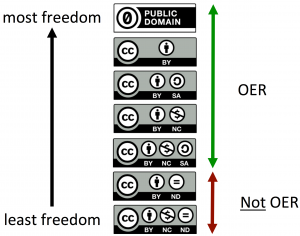What are OER?
This video from the Learning Portal explains what Open Educational Resources (OER) are.
OER Open Educational Resources by the Learning Portal, CC-BY
Why share?
For an introduction on why it is important to share your work as OER, watch this video:
Open Education Matters: Why is it important to share content? Nadia Mireles, CC-BY 3.0
Why should you share your materials? Because education is fundamentally about sharing knowledge and ideas. When we CC license our work, we are sharing that work with the public under simple, legal permissions. Sharing your work is a gift to the world.
Choosing a CC license for OER
One thing to consider as you create your own materials, or revise and remix other’s materials with your own, is what license you want to publish them under. As you know, there are six options, and while all of those licenses have a place in the Open world, in order for your materials to be considered OERs (open educational resources), the licenses must allow for the 5Rs: Retain, reuse, revise, remix, redistribute. This means that while works which contain Non-Derivative or Non-Commercial licenses can NOT be used for materials you wish to designate as OER. Review this chart that details which CC licenses work well for education resources and which do not.

Choosing the right license for your OER requires you to think about which permissions you want to give to other users – and which permissions you want to retain for yourself. Read “Open Textbook Community Advocates CC BY License for Open Textbooks” and think about why they recommend the Creative Commons Attribution License (CC BY) for education. You can find similar text with more arguments made about this same license for publishing scientific research in “Why CC BY?” from Open Access Scholarly Publishers Association.
Other considerations
Other than choosing the right CC license, what other aspects of openness and pedagogy are worth considering? Here is a list of best practices to include in your work when building OER.
The Open Washington Module 8 on “Sharing OER” will give you practical advice on how to share OER online and prepare them to be used offline as well.
Explore this page about Best Practices for Attribution. Among the options listed, think about how you would prefer to be attributed for your own work.
Ensuring OER is Accessible to Everyone
At its core, OER is about making sure everyone has access. Not just rich people, not just people who can see or hear, not just people who can read English, not just people who have digital devices with access to high speed internet – everyone.
As authors and institutions build and share OER, best practices in accessibility need to be part of the instructional and technical design from the start. Educators have legal and ethical responsibilities to ensure our learning resources are fully accessible to all learners, including those with disabilities.
Watch this video on understanding accessibility in digital learning materials:
Simply Said: Understanding Accessibility in Digital Learning Materials, National Center on Accessible Educational Materials, CC BY 3.0.
Best practices to ensure your OER is accessible to all include:
- putting your work into the public domain (CC0) or adding a non-ND CC license to your work,
- make it simple to download your work in editable file formats, so others can modify and/or translate it to meet local needs and make it accessible, and
- most important – design your work to be accessible from the start.
Activity
Take some time to think about what you would like to create for your course. It could be material you have already created, or it could be a mix of your own content with other cc-licensed materials you have found. Once you have put together your content, give it a CC-license that recognizes it as an OER, place it online (use WordPress, Google Docs, or any other open site to present your creation) and link to it in the Comments below.
Final remarks
Thanks for taking this workshop on Integrating Creative Commons Material into your Course(s). We look forward to integrating your suggestions and CC-licensed creations into this material. Contact an instructional designer in eLearning/CETL to learn more.
Attributions
The above content adapted from:
- Open Content to Transform the Classroom by Matthew Bloom, licensed under a Creative Commons Attribution-ShareAlike 4.0 International License (adapted content available at:https://maricopa.instructure.com/courses/805732
- Learn OER managed by the Washington State Board for Community and Technical Colleges licensed under a CC-BY 4.0 (adapted content available at http://www.openwa.org/module-1/)
Leave a Reply